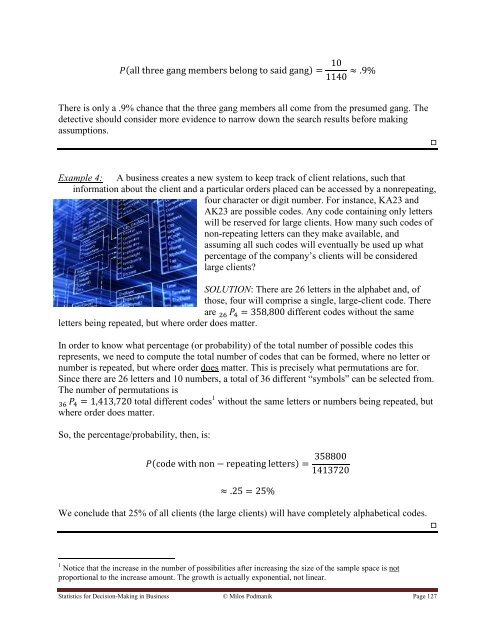Statistics for Decision- Making in Business - Maricopa Community ...
Statistics for Decision- Making in Business - Maricopa Community ...
Statistics for Decision- Making in Business - Maricopa Community ...
Create successful ePaper yourself
Turn your PDF publications into a flip-book with our unique Google optimized e-Paper software.
( )<br />
There is only a .9% chance that the three gang members all come from the presumed gang. The<br />
detective should consider more evidence to narrow down the search results be<strong>for</strong>e mak<strong>in</strong>g<br />
assumptions.<br />
Example 4: A bus<strong>in</strong>ess creates a new system to keep track of client relations, such that<br />
<strong>in</strong><strong>for</strong>mation about the client and a particular orders placed can be accessed by a nonrepeat<strong>in</strong>g,<br />
four character or digit number. For <strong>in</strong>stance, KA23 and<br />
AK23 are possible codes. Any code conta<strong>in</strong><strong>in</strong>g only letters<br />
will be reserved <strong>for</strong> large clients. How many such codes of<br />
non-repeat<strong>in</strong>g letters can they make available, and<br />
assum<strong>in</strong>g all such codes will eventually be used up what<br />
percentage of the company‟s clients will be considered<br />
large clients<br />
SOLUTION: There are 26 letters <strong>in</strong> the alphabet and, of<br />
those, four will comprise a s<strong>in</strong>gle, large-client code. There<br />
are<br />
different codes without the same<br />
letters be<strong>in</strong>g repeated, but where order does matter.<br />
In order to know what percentage (or probability) of the total number of possible codes this<br />
represents, we need to compute the total number of codes that can be <strong>for</strong>med, where no letter or<br />
number is repeated, but where order does matter. This is precisely what permutations are <strong>for</strong>.<br />
S<strong>in</strong>ce there are 26 letters and 10 numbers, a total of 36 different “symbols” can be selected from.<br />
The number of permutations is<br />
total different codes 1 without the same letters or numbers be<strong>in</strong>g repeated, but<br />
where order does matter.<br />
So, the percentage/probability, then, is:<br />
( )<br />
We conclude that 25% of all clients (the large clients) will have completely alphabetical codes.<br />
1 Notice that the <strong>in</strong>crease <strong>in</strong> the number of possibilities after <strong>in</strong>creas<strong>in</strong>g the size of the sample space is not<br />
proportional to the <strong>in</strong>crease amount. The growth is actually exponential, not l<strong>in</strong>ear.<br />
<strong>Statistics</strong> <strong>for</strong> <strong>Decision</strong>-<strong>Mak<strong>in</strong>g</strong> <strong>in</strong> Bus<strong>in</strong>ess © Milos Podmanik Page 127
















